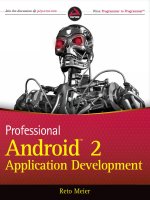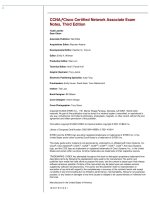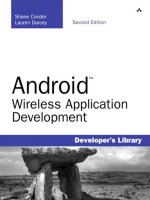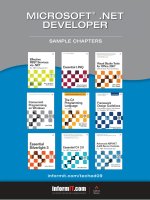Android™ Wireless Application Development, Third Edition doc
Bạn đang xem bản rút gọn của tài liệu. Xem và tải ngay bản đầy đủ của tài liệu tại đây (5.57 MB, 525 trang )
ptg8286261
www.it-ebooks.info
ptg8286261
Android
™
Wireless
Application
Development
Volume II: Advanced Topics
Third Edition
www.it-ebooks.info
ptg8286261
This page intentionally left blank
www.it-ebooks.info
ptg8286261
Android
™
Wireless
Application
Development
Volume II: Advanced Topics
Third Edition
Lauren Darcey
Shane Conder
Upper Saddle River, NJ • Boston • Indianapolis • San Francisco
New York • Toro nt o • Montreal • London • Munich • Paris • Madrid
Cape Town • Sydney • Tok yo • Singapore • Mexico City
www.it-ebooks.info
ptg8286261
Many of the designations used by manufacturers and sellers to distinguish their products
are claimed as trademarks. Where those designations appear in this book, and the
publisher was aware of a trademark claim, the designations have been printed with initial
capital letters or in all capitals.
The authors and publisher have taken care in the preparation of this book, but make no
expressed or implied warranty of any kind and assume no responsibility for errors or
omissions. No liability is assumed for incidental or consequential damages in connection
with or arising out of the use of the information or programs contained herein.
The publisher offers excellent discounts on this book when ordered in quantity for bulk
purchases or special sales, which may include electronic versions and/or custom covers
and content particular to your business, training goals, marketing focus, and branding
interests. For more information, please contact:
U.S. Corporate and Government Sales
(800) 382-3419
For sales outside the United States, please contact:
International Sales
Visit us on the Web: informit.com/aw
Library of Congress Cataloging-in-Publication Data is on file.
Copyright © 2012 Lauren Darcey and Shane Conder
All rights reserved. Printed in the United States of America. This publication is protected by
copyright, and permission must be obtained from the publisher prior to any prohibited
reproduction, storage in a retrieval system, or transmission in any form or by any means,
electronic, mechanical, photocopying, recording, or likewise. To obtain permission to use
material from this work, please submit a written request to Pearson Education, Inc.,
Permissions Department, One Lake Street, Upper Saddle River, New Jersey 07458, or you
may fax your request to (201) 236-3290.
Android is a trademark of Google, Inc. Pearson Education does not assert any right to the
use of the Android trademark, and neither Google nor any other third party having any claim
in the Android trademark have sponsored or are affiliated with the creation and
development of this book.
Some figures that appear in this book have been reproduced from or are modifications
based on work created and shared by the Android Open Source Project and used according
to terms described in the Creative Commons 2.5 Attribution license
( />ISBN-13: 978-0-321-81384-8
ISBN-10: 0-321-81384-7
Tex t pri nte d in the Uni ted S tat es on r ecycl ed paper a t R.R . Don nel ley in C rawf ord svi lle ,
Indiana.
First printing, July 2012
Editor-in-Chief
Mark Taub
Acquisitions Editor
Laura Lewin
Development
Editor
Songlin Qiu
Managing Editor
Kristy Hart
Project Editor
Betsy Harris
Copy Editor
Deadline-Driven
Publishing
Indexer
Lisa Stumpf
Proofreader
Paula Lowell
Technical
Reviewers
Tony H ill erso n
Douglas Jones
Ray Rischpater
Publishing
Coordinator
Olivia Basegio
Multimedia
Developer
Dan Scherf
Book Designer
Gary Adair
Senior Compositor
Gloria Schurick
www.it-ebooks.info
ptg8286261
❖
This book is dedicated to ESC.
❖
www.it-ebooks.info
ptg8286261
This page intentionally left blank
www.it-ebooks.info
ptg8286261
Contents
Introduction 1
I: Advanced Android Application Design Principles
1 Threading and Asynchronous Processing 9
The Importance of Processing Asynchronously 9
Working with the AsyncTask Class 10
Working with the Thread Class 13
Working with Loaders 14
Understanding StrictMode 14
Summary 15
References and More Information 15
2 Working with Services 17
Determining When to Use Services 17
Understanding the Service Lifecycle 18
Creating a Service 18
Controlling a Service 23
Implementing a Remote Interface 24
Implementing a Parcelable Class 26
Using the IntentService Class 29
Summary 33
References and More Information 33
3 Leveraging SQLite Application Databases 35
Storing Structured Data Using SQLite
Databases 35
Creating a SQLite Database 36
Creating, Updating, and Deleting
Database Records 38
Working with Transactions 40
www.it-ebooks.info
ptg8286261
Querying SQLite Databases 41
Closing and Deleting a SQLite
Database 46
Designing Persistent Databases 47
Binding Data to the Application
User Interface 50
Summary 55
References and More Information 55
4 Building Android Content Providers 57
Acting as a Content Provider 57
Implementing a Content Provider
Interface 58
Defining the Data URI 59
Defining Data Columns 59
Implementing Important Content Provider
Methods 59
Updating the Manifest File 65
Enhancing Applications Using Content
Providers 65
Accessing Images on the Device 66
Summary 71
References and More Information 71
5 Broadcasting and Receiving
Intents 73
Sending Broadcasts 73
Sending Basic Broadcasts 74
Sending Ordered Broadcasts 74
Receiving Broadcasts 75
Registering to Receive Broadcasts 76
Handling Incoming Broadcasts from
the System 77
Securing Application Broadcasts 80
Summary 80
References and More Information 81
viii
Contents
www.it-ebooks.info
ptg8286261
ix
Contents
6 Working with Notifications 83
Notifying the User 83
A Word on Compatibility 84
Notifying with the Status Bar 84
Using the NotificationManager Service 85
Creating a Simple Text Notification with
an Icon 85
Working with the Notification Queue 86
Updating Notifications 88
Clearing Notifications 90
Vibrating the Phone 91
Blinking the Lights 92
Making Noise 93
Customizing the Notification 94
Designing Useful Notifications 96
Summary 97
References and More Information 97
II: Advanced Android User Interface Design Principles
7 Designing Powerful User Interfaces 99
Following Android User Interface Guidelines 99
Working with Menus 100
Using Options Menus 100
Using Context Menus 103
Using Popup Menus 105
Enabling Action Bars 105
Building Basic Action Bars 106
Customizing Your Action Bar 110
Handling Application Icon Clicks on the
Action Bar 112
Working with Screens That Do Not Require
Action Bars 114
Introducing Contextual Action Mode 114
Using Advanced Action Bar Features 114
www.it-ebooks.info
ptg8286261
x
Contents
Working with Styles 114
Building Simple Styles 115
Leveraging Style Inheritance 117
Working with Themes 119
Summary 121
References and More Information 122
8 Handling Advanced User Input 123
Working with Textual Input Methods 123
Working with Software Keyboards 123
Working with Text Prediction and User
Dictionaries 126
Using the Clipboard Framework 126
Handling User Events 127
Listening for Touch Mode Changes 127
Listening for Events on the Entire Screen 128
Listening for Long Clicks 129
Listening for Focus Changes 130
Working with Gestures 131
Detecting User Motions Within a View 131
Handling Common Single-Touch Gestures 132
Handling Common Multi-Touch Gestures 139
Making Gestures Look Natural 142
Using the Drag and Drop Framework 143
Working with the Trackball 143
Handling Screen Orientation Changes 144
Summary 146
References and More Information 147
9 Designing Accessible Applications 149
Exploring the Accessibility Framework 149
Leveraging Speech Recognition Services 151
Leveraging Text-To-Speech Services 155
Summary 158
References and More Information 158
www.it-ebooks.info
ptg8286261
xi
Contents
10 Best Practices for Tablet and Google TV
Development 159
Understanding Device Diversity 159
Don’t Make Assumptions about Device
Characteristics 159
Designing Flexible User Interfaces 160
Attracting New Types of Users 161
Leveraging Alternative Resources 161
Using Screen Space Effectively on Big
Landscape Screens 161
Developing Applications for Tablets 162
Developing Applications for Google TV 164
Optimizing Web Applications for Google TV 165
Developing Native Android Applications for
Google TV 165
Developing Apps for the Amazon Kindle Fire 166
Summary 167
References and More Information 168
III: Leveraging Common Android APIs
11 Using Android Networking APIs 169
Understanding Mobile Networking
Fundamentals 169
Understanding Strict Mode with Networking 170
Accessing the Internet (HTTP) 170
Reading Data from the Web 170
Using HttpURLConnection 171
Parsing XML from the Network 172
Handling Network Operations
Asynchronously 174
Retrieving Android Network Status 179
Summary 181
References and More Information 181
12 Using Android Web APIs 183
Browsing the Web with WebView 183
Designing a Layout with a WebView Control 184
Loading Content into a WebView Control 184
www.it-ebooks.info
ptg8286261
xii
Contents
Adding Features to the WebView Control 186
Managing WebView State 189
Building Web Extensions Using WebKit 190
Browsing the WebKit APIs 190
Extending Web Application Functionality to
Android 190
Working with Flash 195
Enabling Flash Applications 195
Building AIR Applications for Android 196
Summary 196
References and More Information 196
13 Using Location-Based Services APIs 197
Using Global Positioning Services (GPS) 197
Using GPS Features in Your Applications 198
Determining the Location of the Device 198
Locating Your Emulator 200
Geocoding Locations 200
Mapping Locations 204
Mapping Intents 205
Mapping Views 206
Getting Your Debug API Key 207
Panning the Map View 209
Zooming the Map View 210
Marking the Spot 211
Doing More with Location-Based Services 216
Summary 217
References and More Information 217
14 Using Android Multimedia APIs 219
Working with Multimedia 219
Working with the Camera 220
Capturing Still Images Using the Camera 220
Working with Video 229
Working with Face Detection 233
www.it-ebooks.info
ptg8286261
xiii
Contents
Working with Audio 233
Recording Audio 233
Playing Audio 235
Sharing Audio 236
Searching for Multimedia 236
Working with Ringtones 238
Summary 238
References and More Information 238
15 Using Android Telephony APIs 239
Working with Telephony Utilities 239
Gaining Permission to Access Phone State
Information 240
Requesting Call State 240
Requesting Service Information 242
Monitoring Signal Strength and Data Connection
Speed 243
Working with Phone Numbers 243
Using SMS 244
Gaining Permission to Send and Receive SMS
Messages 244
Sending an SMS 245
Receiving an SMS 247
Making and Receiving Phone Calls 248
Making Phone Calls 249
Receiving Phone Calls 251
Working with SIP 251
Summary 251
References and More Information 252
16 Accessing Android’s Hardware Sensors 253
Interacting with Device Hardware 253
Using the Device Sensors 254
Working with Different Sensors 254
Configuring the Android Manifest File for
Sensors 255
Acquiring a Reference to a Sensor 256
Reading Sensor Data 256
www.it-ebooks.info
ptg8286261
xiv
Contents
Calibrating Sensors 258
Determining Device Orientation 258
Finding True North 258
Monitoring the Battery 258
Summary 261
References and More Information 261
17 Using Android’s Optional Hardware APIs 263
Working with Bluetooth 263
Checking for the Existence of Bluetooth
Hardware 264
Enabling Bluetooth 264
Querying for Paired Devices 265
Discovering Devices 265
Establishing Connections Between Devices 266
Working with USB 267
Working with USB Accessories 268
Working as a USB Host 269
Working with Android Beam 269
Enabling Android Beam Sending 270
Receiving Android Beam Messages 271
Configuring the Manifest File for Android
Beam 272
Working with Wi-Fi 273
Introducing Wi-Fi Direct 273
Monitoring Wi-Fi State 274
Summary 276
References and More Information 276
IV: Drawing, Animations, and Graphics Programming
with Android
18 Developing Android 2D Graphics
Applications 279
Drawing on the Screen 279
Working with Canvases and Paints 279
www.it-ebooks.info
ptg8286261
xv
Contents
Working with Text 284
Using Default Fonts and Typefaces 284
Using Custom Typefaces 285
Measuring Text Screen Requirements 287
Working with Bitmaps 287
Drawing Bitmap Graphics on a Canvas 287
Scaling Bitmap Graphics 287
Transforming Bitmaps Using Matrixes 287
Working with Shapes 289
Defining Shape Drawables as XML
Resources 289
Defining Shape Drawables Programmatically 290
Drawing Different Shapes 291
Leveraging Hardware Acceleration Features 297
Controlling Hardware Acceleration 298
Fine-Tuning Hardware Acceleration 298
Summary 299
References and More Information 299
19 Working with Animation 301
Exploring Android’s Animation Abilities 301
Working with Frame-by-Frame Animation 302
Working with Tweened Animations 304
Working with Property Animation 309
Working with Different Interpolators 313
Summary 314
References and More Information 314
20 Developing Android 3D Graphics
Applications 315
Working with OpenGL ES 315
Leveraging OpenGL ES in Android 316
Ensuring Device Compatibility 316
Using OpenGL ES APIs in the Android SDK 317
Handling OpenGL ES Tasks Manually 318
Creating a SurfaceView 318
Starting Your OpenGL ES Thread 319
Initializing EGL 321
www.it-ebooks.info
ptg8286261
xvi
Contents
Initializing GL 323
Drawing on the Screen 323
Drawing 3D Objects 325
Drawing Your Vertices 325
Coloring Your Vertices 326
Drawing More Complex Objects 327
Lighting Your Scene 329
Texturing Yo u r Objects 331
Interacting with Android Views and Events 333
Enabling the OpenGL Thread to Talk to the
Application Thread 333
Enabling the Application Thread to Talk to the
OpenGL Thread 335
Cleaning Up OpenGL ES 337
Using GLSurfaceView (Easy OpenGL ES) 337
Using OpenGL ES 2.0 341
Configuring Your Application for
OpenGL ES 2.0 341
Requesting an OpenGL ES 2.0 Surface 341
Working with RenderScript 345
Defining RenderScript Functionality 346
Rendering to a Custom View Control 350
Summary 353
References and More Information 353
21 Using the Android NDK 355
Determining When to Use the Android NDK 355
Installing the Android NDK 356
Exploring the Android NDK 357
Running an Android NDK Sample Application 357
Creating Your Own NDK Project 357
Calling Native Code from Java 358
Handling Parameters and Return Values 359
Using Exceptions with Native Code 360
Using Native Activities 362
Improving Graphics Performance 362
A Comparison to RenderScript 363
Summary 363
References and More Information 364
www.it-ebooks.info
ptg8286261
xvii
Contents
V: Maximizing Android’s Unique Features
22 Extending Android Application Reach 365
Enhancing Your Applications 365
Working with App Widgets 366
Creating an App Widget 367
Installing an App Widget 374
Becoming an App Widget Host 375
Working with Live Wallpapers 375
Creating a Live Wallpaper 376
Creating a Live Wallpaper Service 376
Creating a Live Wallpaper Configuration 378
Configuring the Android Manifest File for
Live Wallpapers 379
Installing a Live Wallpaper 379
Acting as a Content Type Handler 381
Determining Intent Actions and MIME Types 382
Implementing the Activity to Process
the Intents 383
Registering the Intent Filter 384
Summary 384
References and More Information 384
23 Enabling Application Search 385
Making Application Content Searchable 385
Enabling Searches in Your Application 386
Enabling Global Search 395
Summary 398
References and More Information 398
24 Working with Cloud to Device Messaging 399
An Overview of C2DM 399
Understanding C2DM Message Flow 400
Understanding the Limitations of the
C2DM Service 400
Signing Up for C2DM 401
Incorporating C2DM into Your Applications 402
Exploring the C2DM Sample Applications 403
www.it-ebooks.info
ptg8286261
xviii
Contents
What Alternatives to C2DM Exist? 403
Summary 404
References and More Information 404
25 Managing User Accounts and Synchronizing
User Data 405
Managing Accounts with the Account Manager 405
Synchronizing Data with Sync Adapters 406
Using Backup Services 407
Choosing a Remote Backup Service 408
Implementing a Backup Agent 409
Backing Up and Restoring Application Data 412
Summary 414
References and More Information 414
VI: Advanced Topics in Application Publication and
Distribution
26 Internationalizing Your Applications 415
Internationalizing Applications 415
Internationalization Using Alternative
Resources 416
Implementing Locale Support
Programmatically 421
Publishing Applications for Foreign Users 422
Summary 422
References and More Information 422
27 An Overview of Third-Party In-App Billing APIs for
Android 423
What Is In-App Billing? 423
Using In-App Billing 424
Leveraging Android Market In-App Billing APIs 425
Leveraging Amazon Appstore In-App Billing APIs 426
Leveraging PayPal Billing APIs 426
Leveraging Other Billing APIs 427
Summary 427
References and More Information 427
www.it-ebooks.info
ptg8286261
xix
Contents
28 Enabling Application Statistics with Google
Analytics 429
Creating a Google Account for Analytics 429
Adding the Library to Your Eclipse Project 431
Collecting Data from Your Applications 432
Logging Different Events 432
Using the Google Analytics Dashboard 433
Gathering eCommerce Information 436
Logging eCommerce Events in Your
Applications 436
Reviewing eCommerce Reports 437
Tracking A d and Mar ket R e f e r rals 438
Gathering Statistics 438
Protecting Users’ Privacy 439
Summary 439
References and More Information 439
29 Protecting Applications from Software
Piracy 441
All Applications Are Vulnerable 441
Using Secure Coding Practices 442
Obfuscating with ProGuard 442
Configuring ProGuard for Your Android
Applications 443
Dealing with Error Reports After Obfuscation 444
Leveraging the License Verification Library 444
Other Anti-Piracy Tips 445
Summary 446
References and More Information 446
VII: Appendices
A The Android Debug Bridge Quick-Start
Guide 447
Listing Connected Devices and Emulators 447
Directing ADB Commands to Specific Devices 448
Starting and Stopping the ADB Server 448
Stopping the ADB Server Process 448
Starting and Checking the ADB Server
Process 448
www.it-ebooks.info
ptg8286261
xx
Contents
Listing ADB Commands 448
Issuing Shell Commands 449
Issuing a Single Shell Command 449
Using a Shell Session 449
Using the Shell to Start and Stop the
Emulator 450
Copying Files 450
Sending Files to a Device or Emulator 450
Retrieving Files from a Device or Emulator 450
Installing and Uninstalling Applications 451
Installing Applications 451
Reinstalling Applications 451
Uninstalling Applications 452
Working with LogCat Logging 452
Displaying All Log Information 452
Including Date and Time with Log Data 452
Filtering Log Information 453
Clearing the Log 454
Redirecting Log Output to a File 454
Accessing the Secondary Logs 455
Controlling the Backup Service 455
Forcing Backup Operations 455
Forcing Restore Operations 456
Wiping Archived Data 456
Generating Bug Reports 456
Using the Shell to Inspect SQLite Databases 456
Using the Shell to Stress Test Applications 456
Letting the Monkey Loose on Your
Application 457
Listening to Your Monkey 457
Directing Your Monkey’s Actions 457
Training Yo u r Monkey to Repeat His Tric k s 459
Keeping the Monkey on a Leash 459
Learning More About Your Monkey 459
Installing Custom Binaries via the Shell 459
www.it-ebooks.info
ptg8286261
xxi
Contents
B The SQLite Quick-Start Guide 463
Exploring Common Tasks with SQLite 463
Using the sqlite3 Command-Line Interface 464
Launching the ADB Shell 464
Connecting to a SQLite Database 464
Exploring Your Database 465
Importing and Exporting the Database and
Its Data 466
Executing SQL Commands on the
Command Line 468
Using Other sqlite3 Commands 469
Understanding SQLite Limitations 469
Learning by Example: A Student Grade
Database 469
Designing the Student Grade Database
Schema 470
Creating Simple Tables with
AUTOINCREMENT 470
Inserting Data into Tables 471
Querying Tables for Results with SELECT 471
Using Foreign Keys and Composite
Primary Keys 472
Altering and Updating Data in Tables 473
Querying Multiple Tables Using
JOIN 474
Using Calculated Columns 474
Using Subqueries for Calculated Columns 476
Deleting Tables 476
Index 477
www.it-ebooks.info
ptg8286261
Acknowledgments
This book would never have been written without the guidance and encouragement we
received from a number of supportive individuals, including our editorial team, cowork-
ers, friends, and family.We’d like to thank the Android developer community, Google,
and the Open Handset Alliance for their vision and expertise.Throughout this project,
our editorial team at Pearson Education (Addison-Wesley) always had the right mix of
professionalism and encouragement.Thanks especially to Trina MacDonald and Laura
Lewin, Olivia Basegio, Songlin Qiu, and our crack team of technical reviewers: Doug
Jones, Ray Rischpater, and Tony Hillerson, (as well as Dan Galpin,Tony Hillerson,
Ronan Schwarz, Charles Stearns, Mike Wallace, and Mark Gjoel, who reviewed previous
editions and incarnations of this book). Dan Galpin also graciously provided the clever
Android graphics used for tips, notes, and warnings.Amy Badger must be commended
for her wonderful waterfall illustration, and we also thank Hans Bodlaender for letting us
use the nifty chess font he developed as a hobby project.
www.it-ebooks.info
ptg8286261
About the Authors
Lauren Darcey is responsible for the technical leadership and direction of a small soft-
ware company specializing in mobile technologies, including Android, Apple iOS,
Blackberry, Palm Pre, BREW, J2ME, and consulting services.With more than two
decades of experience in professional software production, Lauren is a recognized
authority in application architecture and the development of commercial-grade mobile
applications. Lauren received a B.S. in computer science from the University of
California, Santa Cruz.
She spends her free time traveling the world with her geeky mobile-minded husband
and daughter. She is an avid nature photographer. Her work has been published in books
and newspapers around the world. In South Africa, she dove with 4-meter-long great
white sharks and got stuck between a herd of rampaging hippopotami and an irritated
bull elephant. She’s been attacked by monkeys in Japan, gotten stuck in a ravine with
two hungry lions in Kenya, gotten thirsty in Egypt, narrowly avoided a coup d’état in
Thailand, geocached her way through the Swiss Alps, drank her way through the beer
halls of Germany, slept in the crumbling castles of Europe, and had her tongue stuck to
an iceberg in Iceland (while being watched by a herd of suspicious wild reindeer).
Shane Conder has extensive development experience and has focused his attention on
mobile and embedded development for the past decade. He has designed and developed
many commercial applications for Android, iOS, BREW, Blackberry, J2ME, Palm, and
Windows Mobile—some of which have been installed on millions of phones worldwide.
Shane has written extensively about the mobile industry and evaluated mobile develop-
ment platforms on his tech blogs. He is well-known within the blogosphere. Shane
received a B.S. in computer science from the University of California.
A self-admitted gadget freak, Shane always has the latest smartphone, tablet, or other
mobile device. He can often be found fiddling with the latest technologies, such as cloud
services and mobile platforms, and other exciting, state-of-the-art technologies that acti-
vate the creative part of his brain. He is a very hands-on geek dad. He also enjoys travel-
ing the world with his geeky wife, even if she did make him dive with 4-meter-long
great white sharks and almost got him eaten by a lion in Kenya. He admits that he has to
take at least two phones with him when backpacking—even though there is no cover-
age—and that he snickered and whipped out his Android phone to take a picture when
Laurie got her tongue stuck to that iceberg in Iceland, and that he is catching on that he
should be writing his own bio.
The authors have also published several other Android books, including Android Wireless
Application Development, Android Wireless Application Development Volume I: Android
Essentials, Sams Teach Yourself Android Application Development, Learning Android
™
Application Programming for the Kindle Fire
™
, and the mini-book Introducing Android
Development with Ice Cream Sandwich. Lauren and Shane have also published numerous
articles on mobile software development for magazines, technical journals, and online
www.it-ebooks.info
ptg8286261
publishers of educational content.You can find dozens of samples of their work in Linux
User and Developer, Smart Developer magazine (Linux New Media), developer.com,
Network World, Envato (MobileTuts+ and CodeCanyon), and InformIT, among others.
They also publish articles of interest to their readers at their own Android website,
can find a full list of the authors’ publications at
/>www.it-ebooks.info









